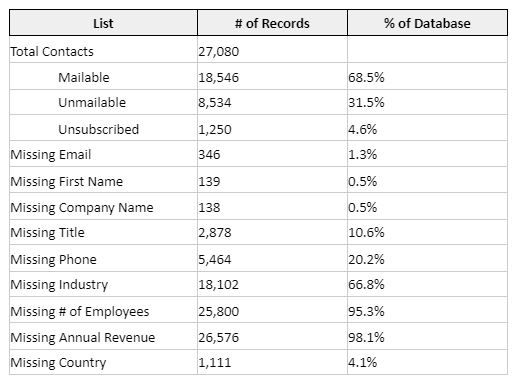Completeness and The Road to Database Quality

Summary
Get started on the road to data quality with an audit to determine the completeness of your marketing database.
By Lisa Heay, Marketing Planning Manager at Heinz Marketing
When we begin a strategic engagement with clients, we look at the five pillars of what we call the predictable pipeline: Target Market, Sales Cycle, Messaging, Tech Stack, and Metrics. For tech stack, we’re not just looking at the tools in your arsenal, but what enables those tools to work, and of course data is the foundation of it all. In short, we want to know if our clients have access to the right data to support their objectives.
Do they have companies in their database that make up their target audience and ideal customer profile? Can they segment their database into buyer persona groups? Do they have fields for and collect location data, job titles, industry, annual revenue, so on? And here is the kicker—is that data complete and up to date?
Database health isn’t necessarily the most exciting aspect of marketing operations, but it’s a crucial foundational element that you simply can’t ignore.
Why should I care about data quality?
Data quality is a big topic, and there are many different aspects to it. According to a blog post from ZoomInfo, “dirty data are faulty bits of information that can present problems in business databases.” And those faulty bits of information arise due to multiple issues: duplicate records, outdated information, incomplete or inaccurate records, and non-compliant records (I’m looking at you GDPR, CAN-SPAM, CCPA, and CASL).
A 2019 study by Forrester and Marketing Evolution found an estimated 21% of respondents’ media budgets were wasted as a result of bad data. In addition, that same study found “decision makers identify access to high-quality data as the No.1 factor driving their marketing performance success.”
Dun and Bradstreet published its “7th Annual B2B Marketing Data Report,” and statistics showed 100% of the B2B companies that increased their investment in data quality saw overall performance gains. About 94% reported their sales and marketing performance improved as well. Of the companies that decreased their investment in data quality, 75% saw a decline in sales and marketing performance.
Bad data can be detrimental to your campaign efforts, too, not just in low conversions and poor performance, but in sales wasting time trying to call people with bad phone numbers, or email undeliverable addresses. Worse yet, bad data contributes to a lack of trust in marketing’s ability to support the sales team.
Data Completeness
Data quality can be a daunting hurdle to overcome, but for this post, I want to focus on incomplete data. To determine how your organization stacks up, a database audit should be a regular marketing operations task on your agenda.
To get started with the database audit, you’ll need to first understand your target audience. What information defines your ideal customer profile? What are the ideal firmographics, technographics, or behavioral signals that make a prospect ideal for your organization?
In addition, you need a clear understanding of the buying committee members and what type of inputs define them—job title for one.
You’ll also need to know what marketing campaigns are planned in order to determine if you have the data to support them. If your demand generation team is planning a campaign with the goal of closing deals at 10 new healthcare companies, but you’re not capturing Industry in order to know if you even have those companies in your database, they either need to adjust their goals, or put a plan in place to gain the data needed.
These segmentations then become the fields you want to pay particular attention to when doing a database audit. Do you have people in your database that meet these requirements?
The simplest way to conduct an audit is to pull lists within your marketing automation platform to get a sense for data completeness based on your targeting. How many leads are mailable vs. undeliverable/unsubscribed? How many are missing an email address, or company name, job title, phone number, industry, location, annual revenue, employee number, etc.?
You could format it into a chart as simple as this:
Now what?
You have your audit and have assessed the completeness of your data. Now what? Take a look at the results of your data. Which fields are standing out to you as incomplete? Now’s the time to make a plan to fill those gaps.
First, it’s important to understand your data inputs. Forms, list imports, manual entries—you need to ensure you are actively collecting the data your organization needs to segment by.
Are there fields you could add to your forms to get the data you need? Or inputs you could require your sales team to enter as they do their prospecting work? You could also utilize progressive profiling to gather more of your important ICP and buyer persona data for your known contacts each time they visit.
Another option, if you don’t have one already, is to utilize a data enrichment tool like ZoomInfo, Clearbit, or SalesIntel. There are many vendors out there for list building and data enrichment.
And don’t be afraid to get rid of the junk. You determined what percentage of your database was unmailable. Get rid of them! They’re taking up precious real estate. That delete button is scary, but your marketing data should be working for you, not against you.
Finally, make a plan to perform this audit again and again. It should be a quarterly exercise—yearly at the very least. Save your smart lists in a folder in your marketing automation platform so that you don’t have to reinvent the wheel each time you do this.
Your marketing and sales database is the foundation of your strategy. Of course, data completeness is only one piece of the data quality puzzle, but it’s an excellent place to start.






